Marc Weidenbaum's Blog, page 248
March 6, 2020
Time Is Passing
“Life” is a track off Essay, a new full-length album from Warmth, aka Agustín Mena, who’s based in València, Spain. It’s thick with heavenly striations — the white-noise wash of waves, whether imaginary or recorded in the field; distant drones, like broken horns echoing down caverns; a lush vocal, evaporating in real time — and all the while a slow pulse trickles by, less a beat than a reminder that time is passing.
Track originally posted at soundcloud.com/w_a_r_m_t_h. Get the full album at archivesdubmusic.bandcamp.com.
March 5, 2020
Disquiet Junto Project 0427: Music 4 Airplanes

Each Thursday in the Disquiet Junto group, a new compositional challenge is set before the group’s members, who then have just over four days to upload a track in response to the assignment. Membership in the Junto is open: just join and participate. (A SoundCloud account is helpful but not required.) There’s no pressure to do every project. It’s weekly so that you know it’s there, every Thursday through Monday, when you have the time.
Deadline: This project’s deadline is Monday, March 9, 2020, at 11:59pm (that is, just before midnight) wherever you are. It was posted on Thursday, March 5, 2020.
These are the instructions that went out to the group’s email list (at tinyletter.com/disquiet-junto):
Disquiet Junto Project 0427: Music 4 Airplanes
The Assignment: Make music that blends in with the industrial drone of modern air flight.
Step 1: Airplanes are noisy places, especially when at 35,000 feet. Consider the noise, especially the dense white noise, experienced by an airline passenger.
Step 2: Record a short piece of music that is intended to blend in with the industrial drone of modern air flight.
Seven More Important Steps When Your Track Is Done:
Step 1: Include “disquiet0427” (no spaces or quotation marks) in the name of your track.
Step 2: If your audio-hosting platform allows for tags, be sure to also include the project tag “disquiet0427” (no spaces or quotation marks). If you’re posting on SoundCloud in particular, this is essential to subsequent location of tracks for the creation of a project playlist.
Step 3: Upload your track. It is helpful but not essential that you use SoundCloud to host your track.
Step 4: Post your track in the following discussion thread at llllllll.co:
https://llllllll.co/t/disquiet-junto-project-0427-music-4-airplanes/
Step 5: Annotate your track with a brief explanation of your approach and process.
Step 6: If posting on social media, please consider using the hashtag #disquietjunto so fellow participants are more likely to locate your communication.
Step 7: Then listen to and comment on tracks uploaded by your fellow Disquiet Junto participants.
Additional Details:
Deadline: This project’s deadline is Monday, March 9, 2020, at 11:59pm (that is, just before midnight) wherever you are. It was posted on Thursday, March 5, 2020.
Length: The length is up to you. Shorter is often better, but then again, flights are long. Perhaps make something that readily loops.
Title/Tag: When posting your track, please include “disquiet0427” in the title of the track, and where applicable (on SoundCloud, for example) as a tag.
Upload: When participating in this project, post one finished track with the project tag, and be sure to include a description of your process in planning, composing, and recording it. This description is an essential element of the communicative process inherent in the Disquiet Junto. Photos, video, and lists of equipment are always appreciated.
Download: Consider setting your track as downloadable and allowing for attributed remixing (i.e., a Creative Commons license permitting non-commercial sharing with attribution, allowing for derivatives).
For context, when posting the track online, please be sure to include this following information:
More on this 427th weekly Disquiet Junto project — Music 4 Airplanes / The Assignment: Make music that blends in with the industrial drone of modern air flight — at:
More on the Disquiet Junto at:
Subscribe to project announcements here:
http://tinyletter.com/disquiet-junto/
Project discussion takes place on llllllll.co:
https://llllllll.co/t/disquiet-junto-project-0427-music-4-airplanes/
There’s also a Disquiet Junto Slack. Send your email address to twitter.com/disquiet for Slack inclusion.
March 4, 2020
Filling Out a Silhouette
Sometimes the drone is the text, and sometimes it’s the subtext. It’s the text when it’s the overarching sound. It’s the subtext when it fills out some other overarching construct. The latter is the case with “Emporium Drone 005” by Cousin Silas. In it, the contour of a lush melody — halfway between neo-classical and popular song — played at a sedate pace is treated as if it were a silhouette, a shape left to be filled by an assembly of Silas’ drones. The overall effect is that of an orchestra heard through a thick, velvet scrim.
More from Cousin Silas, aka the English musician David Hughes, at cousinsilas1.bandcamp.com, as well as at wikipedia.org, which lists the over 80 albums he has released since 2001.
March 3, 2020
In Situ
You can play this video in lots of contexts. You can play it on your phone, or your laptop, maybe in a little side window, or real big. You can project it to a screen. Or you can play it on a tablet. I recommend tablet. The reason I recommend tablet, specifically iPad, is this video was performed in the software called Samplr on an iPad. To play the video on an iPad is to play it on the same device where the music was performed and recorded — in situ, as it were. (The Samplr app recently received an update for the first time in something like half a decade. It had continued to work fine, but its developer finally modernized it, resulting in a deserved resurgence of popularity, resulting in videos like this one.) Here the sampling app is put to ambient purposes. As the musician Haik works through the samples, you can track the correlation between actions and sounds.
This is the latest video I’ve added to my YouTube playlist of recommended live performances of ambient music. Video originally published at YouTube. More from Haik, who is based in Japan, at twitter.com/haik_am and instagram.com/haikmusic_.
Infrastructure Collapse
A friendly reminder from the New York City subway system that infrastructure collapse can be beautiful:

March 2, 2020
Deep, Fluxing Pulse
The Oo-ray is Ted Laderas, best known for his shoegaze-drenched cello music, wherein he runs his trusty analog four-string instrument through a shifting array of loopers and synths. Laderas is also handy with synths on their own, as this gently throbbing, tastily peaked-out ambient track displays. Listen as the deep, fluxing pulse pushes past its breaking point at times, and then how the spirited rasps of noise get folded back into the greater whole.
Track originally posted at soundcloud.com/ooray. More from Laderas, who is based in Portland, Oregon, at 15people.net and waveguideaudio.bandcamp.com.
March 1, 2020
Taxonomy of Speakers at MoMA
Tasty as the sausages may be, sometimes paying attention to how they’re made can be just as enticing, maybe even more.
I spent the afternoon at the Museum of Modern Art in Manhattan before heading back home to San Francisco, the close of a somewhat sudden and quick trip to the city. The range of audio speakers throughout the newly redesigned MoMA, their placement and purpose, provided hints at the role sound was intended to play in the varied exhibits.
The museum today is less than ever a staid assembly of neutral zones. Since reopening in late 2019, MoMA is more a refined theme park, the design of adjacent rooms clashing, purposefully, with their neighbors. The paths are circuitous, disorienting, exploratory. The transitions between zones make each successive exhibit you wander through feel less like an autonomous space, and more like it’s in conversation with the places you’ve been through and are headed to.
When you enter a given space, you may hear something, but excepting rooms dedicated to individual works, it can be unclear which piece correlates with the sound. Speakers are everywhere. Room after room you enter has audio; the question becomes: From which of these many pieces in front of me is it emanating? This isn’t a puzzle. It never takes long to sort out. But in the process of untangling several such circumstances, patterns begin to form and cluster, and in turn a taxonomy of the speakers comes into shape.
There are speakers placed within the art in a compelling way. These speakers are visually, structurally, compositionally part of a whole:
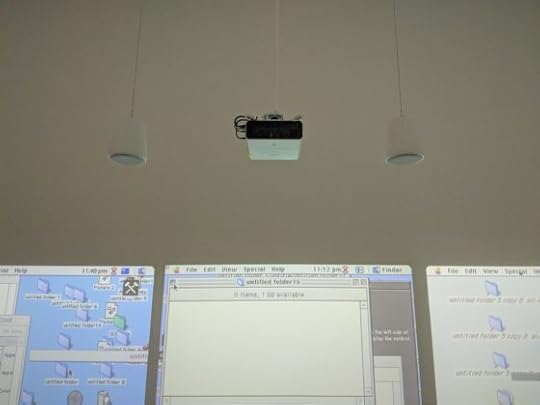
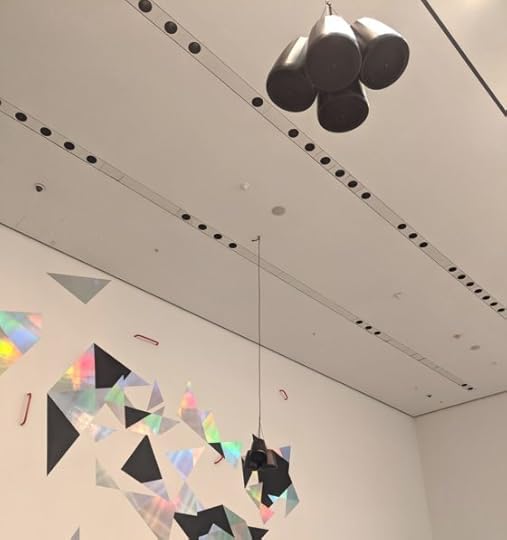
There are speakers off to the side or up in a corner, participating but not acknowledged. Their role is, in effect, un-credited. They are infrastructure, not art:
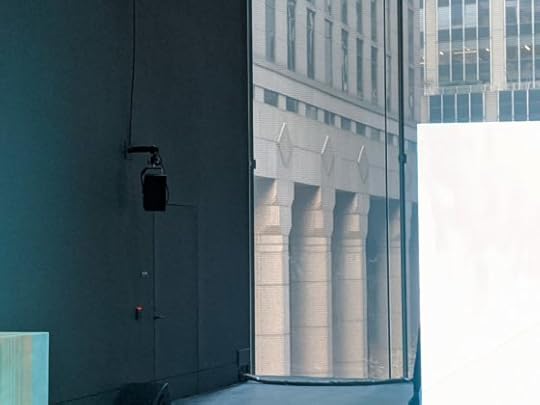
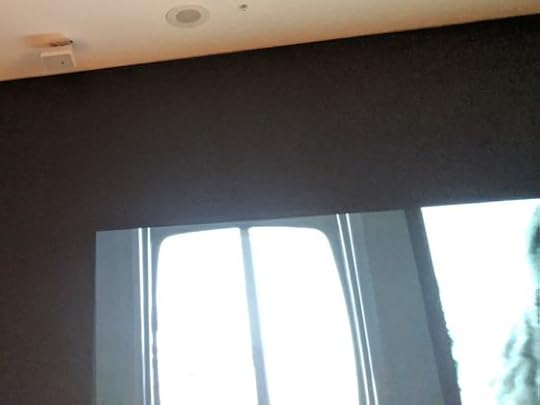
There are invitations to listen — some traditional headphones, others ingenious single-ear devices. The traditional headphones suggest you sit and stay, the single-ear ones that you might dip in and get a sense of the piece:
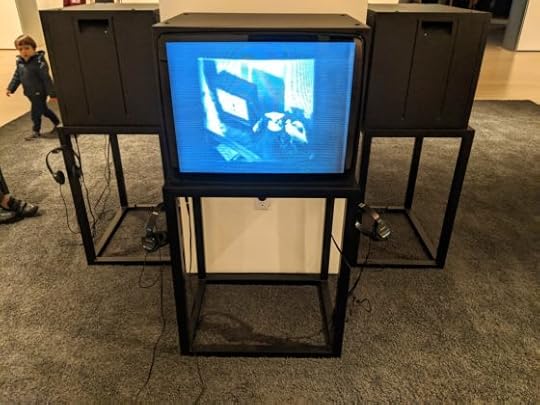
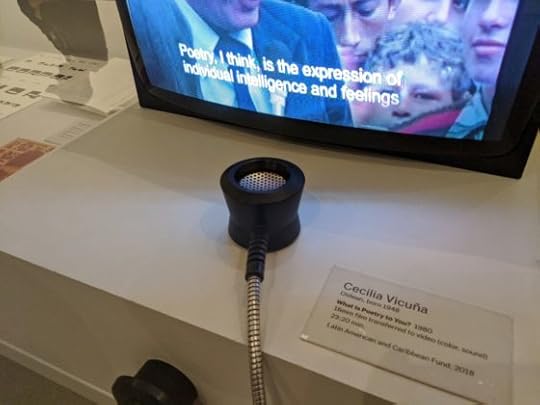
There is plenty of video that has no sound at all. Some of those pieces, for no readily apparent reason, make the effort, in the accompanying curatorial text, to inform the audience the works are, in fact, silent. One example is this 1985 piece, “Reabracadabra” by the artist Eduardo Kac. It runs on an old Philips Minitel terminal:
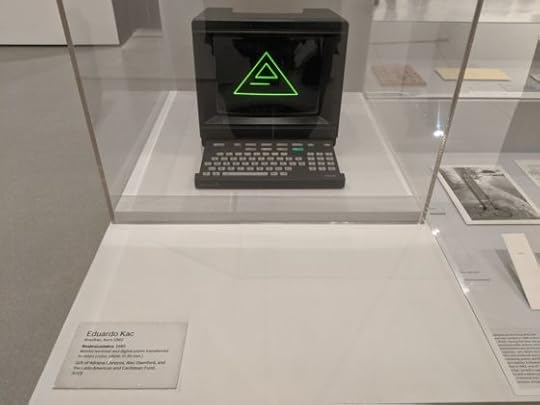
And then, after witnessing all these MoMA speakers, there are the pieces with no sound, no electronics at all, but that come to look like speakers, such as this untitled 1957 piece by Hélio Oiticica:

February 29, 2020
A Cooperative Community
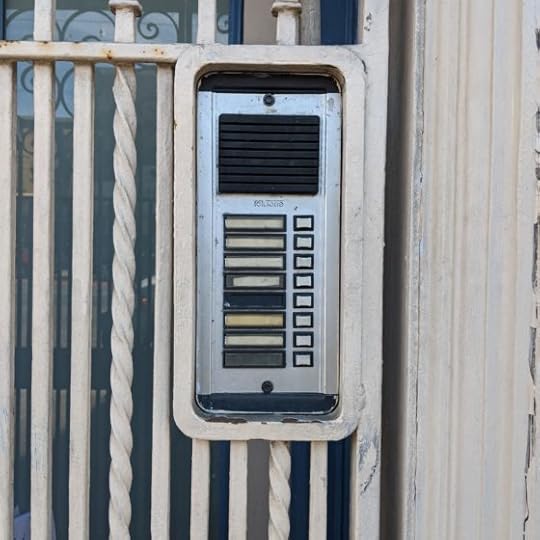
The mundane isn’t necessarily banal. The mundane can impose a weight, a presence, a deficit, one that stands in contrast with its seeming everyday-ness, its ordinariness, its blanket generality. Take, for example, the blank face with which this doorbell interface meets a visitor. There are eight rows of virtually indistinguishable units. The buttons on the right are uniform. The ones on the left might once have displayed the names of the occupiers, but the horizontal slats are now merely variations on decay: three top rows of reluctant white; then one that’s been trimmed on both sides, like someone long ago tried to swap in a replacement bit of paper; then a dark blank, the base background, presumably, of all the others; then a yellowed swath, telegraphing the nicotine coloration of its inhabitant’s aged teeth; then a brief coda of the originating quasi-white; and then a strange grey, hard for the eye to focus on, the truest absence among myriad other absences. How all but the top and bottom units’ residents might even instruct visitors to announce their arrival is unclear (“Hit the one near the middle, below the darkest one”). Perhaps there are no visitors to this building these days, and there haven’t been for longer than anyone has any desire to recall. Perhaps this address is some sort of co-op, in the ancient sense of the term, a cooperative community, whose members’ names once proudly adorned the entrance in a public display of vertically integrated solidarity, but whose mutual interdependence rose over the years in inverse proportion as the names faded and, eventually, entirely disappeared.





